
Salty Sam’s Fun Blog for Children
Number 304
Birds’ Nests
Hello Everyone

With Christmas on its way, we all like to put a few decorations up, don’t we?
A lot of people put decorations on their house and in their garden so that everyone else can enjoy them.
My Auntie Alice is no exception.
And last week, she decided it was about time she went out into the garden and started to string a few fairy lights around.
While she was out there, she thought that the garden needed a bit of a tidy up too and her main focus should be a long hedge down one side of a rather overgrown lawn.
As the hedge jiggled around with her shears clipping into it, what should fall out, but a small, round object.
On closer inspection, she found that it was a dried-up birds’ nest.
She marvelled at the intricacy of the work and decided to show the children the next time they came round. lt was obviously an abandoned nest – probably made by a robin or blackbird.
lt was constructed from thin grasses tightly woven together in such a careful manner it was strange to think that an animal had been clever enough to make it.
When the children saw the nest they wanted to take it into school and show Miss Pringle and the rest of their class.
Auntie Alice agreed because she said that the bird didn’t need it anymore. lt was beginning to fall apart and at one time there would have been a lining in it made from softer matter and it seemed to have blown away.
Birds like to line their nests, once they have made them, with feathers and leaves in order to keep their eggs tightly in a clutch and as warm as possible. Some birds can even use spiders’ webs. Wrens can do this. They are the smallest birds in Britain, but they build quite big nests because they tend to have quite big families.
All those baby birds need room to grow!
The lining also makes for a more comfortable nest for the baby chicks once they have hatched out of their eggs.
Miss Pringle was very interested in Bill, Bob and Emily’s find and showed it to the class straight away.
Miss Pringle said that the bird kingdom had such a huge variety of birds that we only see a few of all the birds there are in the world in our own gardens.
There are enormous, flightless ostriches that live on the African plains and other birds that live in the sky for years without landing.
There are colourful macaws that live in tropical rainforests that can learn to mimic sounds so well that they sound as though they can speak like humans, and other birds who sing beautiful songs that sound like music.
There are birds of prey that are so big they can carry away a goat and humming birds so small that they hardly weigh anything at all.
When you look at a bird you can have a pretty good guess at the kind of life it lives. This is nature adapting itself to its environment.
Look at their feathers, beaks and feet and they will all give you clues.
Unlike other animals, birds have feathers. Males are often more brightly-coloured than females. The males like to show themselves off. The females often sit on a nest to rear their young and need to be camouflaged when they do so. Flightless birds have fluffy feathers.
lnsect-eaters, like robins, have pointed beaks. lf a bird like a finch wants to crack open nuts or seeds, a broader beak is better. Long beaks like the ones curlews have, are useful for probing in mud for food. A pouched beak of a pelican acts as a fishing bag and a hook beak like a hawk has is a sharp tool for tearing flesh.
Humming birds on the other hand, feed on nectar and have especially long beaks that can reach far down into tropical flowers.
The webbed foot of a duck or swan is useful for swimming in water. Birds that you see in your gardens like robins and blackbirds have perching feet so that they can sit high up in trees and birds of prey like eagles have huge talons that can grip onto prey as they carry it off.
Most birds make a nest of some kind to protect their eggs and chicks. Some go to great lengths to build homes that are clever examples of construction.
They often line their nests too with some kind of soft material, maybe even down and feathers pulled from their own plumage.
The lining helps to keep the clutch of eggs together, but insulated against the cold as well.
The parent bird will turn the eggs from time to time to ensure the proper development of the bird inside.
Some birds, like magpies, make nests of twigs, others nest in holes in trees. lf a woodpecker doesn’t think a hole it has found is big enough, it can work on it with its beak to make it bigger. Sand martins burrow into cliffs. Puffins’ burrows are underground.
The weaver bird twists grasses together to make its nest and hooks it firmly onto rushes.
So does a reed warbler, and the nest will move about quite violently when a strong wind is blowing.
Some birds, like crows and rooks, build their nests high in the trees and others, like ducks, on the ground.
When a nest is built high up, there are usually more branches around the nest for the baby birds to crawl around on, therefore, less likelihood that the birds will fall to the ground and perish.
Some nests are by the river, some are floating on the river and others are in hedgerows. Kingfishers nest inside river banks.
Penguins in Antarctica build their nests on the ground with pebbles because there is nothing else for them to use. Other birds just dig holes in the sand.
Flamingos build little mud mounds to keep their eggs above fluctuating water levels.
Some birds build cup nests like the one Auntie Alice found and some weave what are called pendant nests. They look like balloons hanging from tree branches.
The goldcrest is a very tiny bird; but it is very hard-working. lt will built two or even three nests in a breeding season. The nests are built from material collected from around the nest and stuck together with spiders’ webs, which as you probably know, are very sticky. While the female is sitting on a clutch of eggs in the second nest the male is busy feeding the birds that have already hatched in the first.
Some birds love to use buildings as nesting sites.
Pigeons in big cities build their nests on ledges they can find because before high building were built they lived on cliffs.
Some owls like to nest in barns and house martins make their nests out of mud under the eaves of a roof.
Storks build the most enormous platforms on top of houses.
Of course sometimes humans help birds out. They put up platforms for storks, nesting boxes in the woods and swift boxes under house roofs.
ln the end it was a very interesting lesson and the children were glad that Auntie Alice had found the nest.
Bye bye everyone – don’t forget to subscribe to my blog!
lf you like my blog, please support it by telling all your friends and followers about it.
Thank you!
And see you again next Fun Friday!
Love and kisses
Salty Sam

www.christina-sinclair.com


Bill and Bob’s Joke of the Week![]()
![]()
Bob: What is a pelican’s favourite food?
Bill: l don’t know. What did is a pelican’s favourite food?
Bob: Anything that fits the bill!

Salty Sam © Christina Sinclair 2015
Unauthorized use and/or duplication of material from this blog without express and written permission from this blog’s author and owner is strictly prohibited.
Links may be used to www.christina-sinclair.com

Picture Gallery
 Curlew with a beak that can probe into mud
Curlew with a beak that can probe into mud
 Pelican
Pelican
 A goldcrest
A goldcrest
 Nests in the shape of a cup keep the eggs safely together
Nests in the shape of a cup keep the eggs safely together
 Weaver birds’ nests
Weaver birds’ nests
 A flamingo’s nest
A flamingo’s nest
 A humming bird’s nest
A humming bird’s nest
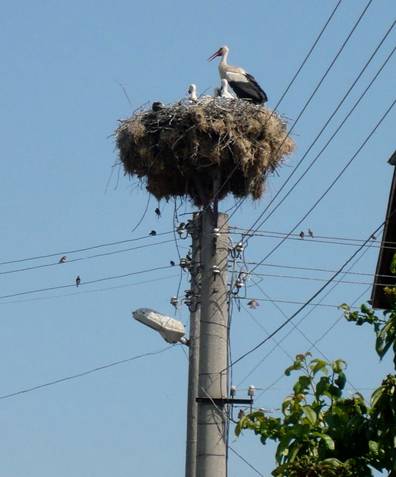 A stork’s nest
A stork’s nest


 THE SALTY SAM NEWS DESK
THE SALTY SAM NEWS DESK

Each spring Auntie Alice plants up lots of seedlings and cuttings to make her garden look spectacular in the summer and autumn months.
It is a lot of work.
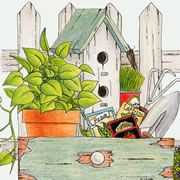
But one thing she does to make the job less expensive is to make her own pots to plant the seedlings in.
The children love helping her.
There are two ways to make them.
The first type is made out of the inner tubes of kitchen paper rolls.
She puts four cuts at equal distances around one end. They are about 4cm in length. She folds in the four flaps that she has made to create bottoms for the pots. These pots can then be lined up in a seed tray so that they don’t fall over.
The other kind is of pot is made from wrapping a sheet of newspaper around a narrow bottle leaving an overlap at the bottom. First you need to cut the paper in half and discard the staples.
A small water bottle can be used. You may find it easier to work with when it is full of water because it will be more solid.
Turn the bottle upside down and scrunch the paper down onto the base.
Turn the bottle the right way up. Push it down onto the table to flatten the bottom of the pot.
Both these home-made pots need to be propped up in seed trays to keep them upright.
The water will drain out of the bottom of the pots and then the trays so they must be resting on something that will catch all the water.
One or two seeds or a small cutting can be put into each pot.
As the plants grow the pot will start to get a bit mushy.

Don’t worry, because when the plants are planted out in the garden, the pots will dissolve into the soil as the plants grow.
Plant them out when they are quite dry so that they are easier to handle but then water them well when they are in the ground.
The main purpose of growing plants like this is that the plant has no root disturbance when it is planted out. Then it will be really happy to start growing away.
But there are other benefits too. It saves you a lot of time thinning out seedlings and it stops your seedlings being wasted too because they will not be growing too closely together – they will be well-spaced out in their pots.
You can use these pots for growing flowers and vegetables too.
Of course, if you plan to do this in the spring, you will need to start collecting tubes and maybe even newspapers too well before that time.
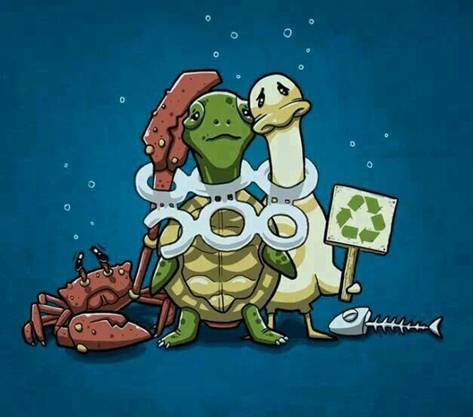
Some people snip plastic rings before they discard them
so that this can never happen
Recycling is always the best policy

*********************
TO ADVERTISE ON THIS BLOG
PLEASE CONTACT:
christina.sinclair.ads@aol.co.uk
*********************


Quick Quiz
Can you un-jumble these words to find birds that might visit your garden?
- drabbclik
- shruth
- tubilet
- wosrarp
- flunblich
- sirtlang
- biron
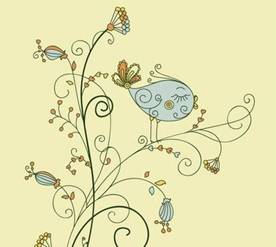



lt’s the Weekend!
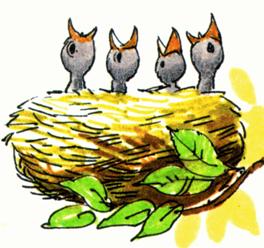
HOW TO MAKE A DlGlTAL CAMERA CASE
You will probably already have a cover for your camera, but this one will give extra padding around the camera for when you carry it around.
CAMERA CASE (KNIT TWO)
Using 4mm knitting needles and purple dk yarn cast on 28 stitches
Knit 10 rows of stocking stitch
Change to white dk yarn
Knit 1 row
Knit 1 row
Change to purple yarn
Knit 8 rows of stocking stitch
Change to white dk yarn
Knit 1 row
Knit 1 row
Repeat the last 10 rows 2 times
Change to purple yarn
Knit 8 rows of stocking stitch
Purl 1 row
Purl 1 row
Knit 1 row
Purl 1 row
knit 1 row
Purl 1 row
Change to white yarn
Knit 4 rows of garter stitch
Cast off
TO MAKE UP
Sew up the bottom and side seams using over-sew stitching with right sides together.
Turn the case the right way out.
Make a cord by crocheting 100 chains into a length of white yarn and thread it around the top of the case.

Please note that the material on this blog is for personal use and for use in classrooms only.
It is a copyright infringement and, therefore, illegal under international law to sell items made with these patterns.
Use of the toys and projects is at your own risk.
©Christina Sinclair Designs 2015


Quick Quiz Answers
- Blackbird
- Thrush
- Blue tit
- Sparrow
- Bull finch
- Starling
- Robin



